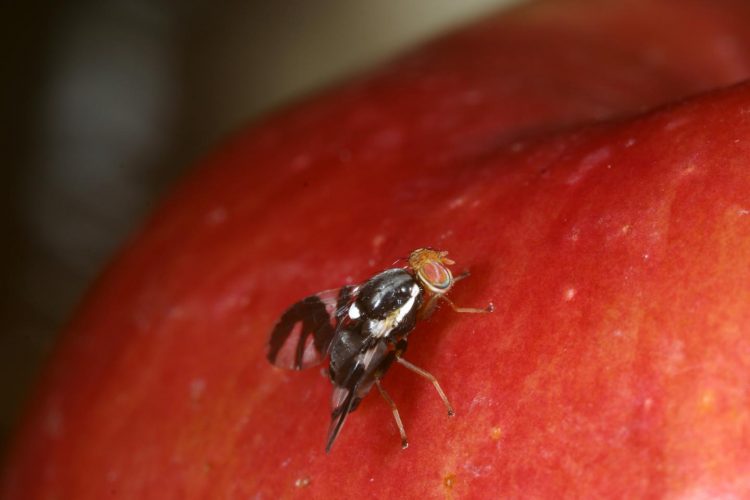Caught in the act: New wasp species emerging

A Rhagoletis pomonella fly explores the derived host fruit, an apple. Credit: Andrew Forbes
The concept that biodiversity feeds upon itself is an old idea, but it's difficult to prove because it requires biologists to simultaneously catch several species red-handed just as they are becoming new species. Now biologists have proof.
A new study from biologists at Rice University, the University of Notre Dame, Michigan State University, the University of Iowa and the University of Florida finds that ongoing evolutionary changes in one fruit fly species are having a domino effect on at least three species of predatory wasps. The researchers focused on the jump of a native North American fruit fly onto apple trees in the 1850s.
“Our study addresses one of the central questions in biology: How do new forms of life originate?” said evolutionary biologist Scott Egan, assistant professor of biosciences at Rice and a co-author of the new study, which is available online in the Proceedings of the National Academy of Sciences.
The study follows up previous research by Egan and colleagues of the fruit fly Rhagoletis pomonella, aka the “apple maggot,” which began plaguing U.S. apple growers in the 1850s. That work showed that changes in feeding and mating habits of Rhagoletis are driving it to become two different species.
“Our new work takes a close look at the evolutionary process termed 'sequential speciation,'” Egan said. “Sequential speciation identifies the fact that adaptation and speciation of one species is not an isolated process. The appearance of a new species creates new niche opportunities that can be exploited by other species, and that opportunity can promote the origin of other new species.”
Rhagoletis is in the act of evolving into two species. The change is driven by differently timed fruiting cycles between apple trees, which some Rhagoletis prefer, and the North American hawthorn, the native fruit where Rhagoletis have traditionally laid their eggs. In extending their work on Rhagoletis speciation, the researchers focused on three species of wasps that are known parasites for Rhagoletis.
Wasps were collected from a number of different fly host plant environments in the wild. Analyses showed that all three wasp species were also in the process of diverging into two distinct species, both genetically and with respect to host-associated physiology and behavior.
“The new study extends the earlier work by showing that new fruit fly species provide suitable habitat not just for one new parasitoid species, but for multiple new species,” said study co-author James Smith, a Michigan State entomologist.
These evolutionary changes, which are known as “sequential” or “cascading” events, may provide additional information to help biologists explain why certain organisms like plants and insects are more diverse and species-rich than other groups are.
“Why are there so many insect species?” Smith asked. “Speciation cascades provide one explanation for how a lot of species might be generated in a relatively short period of time.”
Glen Hood, a Ph.D. student at Notre Dame and lead author of the paper, said, “Our study has impacted our understanding of evolution by suggesting that change in individual lineages can reverberate through different trophic levels of an ecosystem and increase community-level biodiversity.”
###
Additional co-authors include Notre Dame's Jeffrey Feder, Iowa's Andrew Forbes and Gabriela Hamerlinck, and Florida's Thomas Powell. The research was supported by the National Science Foundation, the Indiana Academy of Science, the Entomological Society of America and Sigma Xi.
High-resolution IMAGES are available for download at:
http://news.
CAPTION: The parasitic wasp, Utetes canaliculatus, on a snowberry shrub, searching for its Rhagoletis fly host.
CREDIT: Hannes Schuler
http://news.
CAPTION: A Rhagoletis pomonella fly explores the derived host fruit, an apple.
CREDIT: Andrew Forbes
http://news.
CAPTION: Scott Egan
CREDIT: Jeff Fitlow/Rice University
A copy of the PNAS paper is available at: http://www.
Related Rice research:
Evolution study finds massive genome shift in one generation — June 15, 2015
This release can be found online at news.rice.edu.
Follow Rice News and Media Relations via Twitter @RiceUNews
Located on a 300-acre forested campus in Houston, Rice University is consistently ranked among the nation's top 20 universities by U.S. News & World Report. Rice has highly respected schools of Architecture, Business, Continuing Studies, Engineering, Humanities, Music, Natural Sciences and Social Sciences and is home to the Baker Institute for Public Policy. With 3,888 undergraduates and 2,610 graduate students, Rice's undergraduate student-to-faculty ratio is 6-to-1. Its residential college system builds close-knit communities and lifelong friendships, just one reason why Rice is ranked No. 1 for best quality of life and for lots of race/class interaction by the Princeton Review. Rice is also rated as a best value among private universities by Kiplinger's Personal Finance.
Media Contact
All latest news from the category: Life Sciences and Chemistry
Articles and reports from the Life Sciences and chemistry area deal with applied and basic research into modern biology, chemistry and human medicine.
Valuable information can be found on a range of life sciences fields including bacteriology, biochemistry, bionics, bioinformatics, biophysics, biotechnology, genetics, geobotany, human biology, marine biology, microbiology, molecular biology, cellular biology, zoology, bioinorganic chemistry, microchemistry and environmental chemistry.
Newest articles

First-of-its-kind study uses remote sensing to monitor plastic debris in rivers and lakes
Remote sensing creates a cost-effective solution to monitoring plastic pollution. A first-of-its-kind study from researchers at the University of Minnesota Twin Cities shows how remote sensing can help monitor and…

Laser-based artificial neuron mimics nerve cell functions at lightning speed
With a processing speed a billion times faster than nature, chip-based laser neuron could help advance AI tasks such as pattern recognition and sequence prediction. Researchers have developed a laser-based…

Optimising the processing of plastic waste
Just one look in the yellow bin reveals a colourful jumble of different types of plastic. However, the purer and more uniform plastic waste is, the easier it is to…



